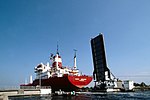Café Gondrée
Bascule bridgesBritish airborne landings in NormandyBuildings and structures in Calvados (department)Coffeehouses and cafés in FranceMilitary history of France during World War II ... and 4 more
Military history of NormandyOperation OverlordTourist attractions in Calvados (department)World War II sites in France

The Café Gondrée is a small coffeehouse in the French community of Bénouville. The cafe is located on the west bank of the Caen Canal, at the northwest end of the Bénouville Bridge, now commonly referred to as the Pegasus Bridge. The building was the site of first combat during the D-Day invasion, and is best known for its role commemorating those events.
Excerpt from the Wikipedia article Café Gondrée (License: CC BY-SA 3.0, Authors, Images).Café Gondrée
Voie Verte Caen-Ouistreham, Caen
Geographical coordinates (GPS) Address External links Nearby Places Show on map
Geographical coordinates (GPS)
| Latitude | Longitude |
|---|---|
| N 49.242416666667 ° | E -0.27497222222222 ° |
Address
Café Gondrée
Voie Verte Caen-Ouistreham
14970 Caen
Normandy, France
Open on Google Maps










